Az occlusio és az extrakció szerepe a fogszabályozásban
Történelmi áttekintés
Absztrakt
A fogorvostudomány minden területén, így az orthodontiában is fontos az occlusio pontos ismerete és történeti fejlődése. A szerzők ismertetik az occlusióval foglalkozó tanulmányok történetét az irodalmi adatok tükrében, kiemelve az orthodontia és ezen belül az occlusio jelentőségét a fogszabályozás történetében mint a kezdeti időszakban, az ún.
aranykorszakban és a jelen korban. A történelmi összefoglaló áttekintést ad az orthodontia jelentősebb alakjairól, munkásságáról és az orthodontiai beosztásokról a három periódusnak megfelelően. A fogszabályozás kezdeti korszakában jelentek meg az első kezdetleges beosztások, majd 1899-ben Angle publikálta a még napjainkban is széles körben elfogadott klasszifikációját. E korszak elöljárói E. H. Angle mellett P. Fauchard, F. C. Kneisel és C. Case voltak. Az aranykorszak során továbbra is az Angle-féle osztályozást alkalmazták, de az extrakciós elvek megváltoztak. Ezen téziseket többek között C. F. Ballard, P. R. Begg és C. H. Tweed képviselte. A jelenkori fogszabályozás elveit L. F.
Andrews és R. H. Roth alapozták meg. A normál occlusio fogalmának ismerete nemcsak az orthodontiában lényeges, hanem a protetikában és a gnathologiában is.
Copyright (c) 2021 Szerzők

This work is licensed under a Creative Commons Attribution 4.0 International License.


.png)




1.png)



